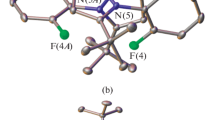Abstract
Three different types of iron(III) complexes, Fe(A)3, Fe(A)2(A') and Fe(A)(A')2, whereA is either piperidyldithiocarbamate or morpholyl dithiocarbamate andA' is glycine(oxine) acetylacetone have been prepared by reacting Fe(III) salt with sodium salt of piperidinedithiocarbamic acid or morpholine-dithiocarbamic acid and acetylacetone(oxine)-glycine in different ratios. The mixed ligand complexes have been characterised by elemental analysis, magnetic susceptibility measurements, infrared, electronic spectral techniques and by thermal analysis. Electronic spectral studies suggests that all the complexes possess distorted octahedral geometry. The magnetic moment of the high spin iron(III) complexes lies in the range of 5.88–6.00 and for low spin lies in the range of 3.36–4.34 B.M. TG studies show one step decomposition of complexes and formation of Fe2O3 at the end of the step.
Zusammenfassung
Durch Reaktion von Fe(III)-salzen mit dem Natriumsalz der Piperidin-dithiocarbaminsäure oder der Morpholin-dithiocarbaminsäure und Acetylaceton/Oxin/Glycin in verschiedenem Molverhältnis wurden drei Typen von Fe(III)-komplexen hergestellt: Fe(A)3, Fe(A)2(A') und Fe(A)(A')2 mitA=Piperidyldithiocarbamat oder Morpholyldithiocarbamat undA'=Glycin/Oxin/Acetylaceton. Die einzelnen Komplexe wurden mittels Elementaranalyse, Messungen der magnetischen Suszeptibilität, IR- und Elektronenspektren sowie Thermoanalyse beschrieben. Elektronenspektren zufolge verfügen alle der Komplexe über eine verzerrte oktaedrische Geometrie. Bei diesen Eisen(III)-komplexen liegt das magnetische Moment der Normalkomplexe im Bereich 5.88–6.00 und das der Durchdringungskomplexe im Bereich 3.36–4.34 B.M. TG-Untersuchungen zeigten eine einstufige Zersetzung der Komplexe unter Bildung von Fe2O3 als Endprodukt.
Similar content being viewed by others
References
G. D. Thorn and R. A. Ludwig, “The Dithiocarbamates and Related Compounds”, Elsevier Publishing Company, New York 1962.
J. Willemse, J. A. Cras, J. J. Steggerda and C. P. Kiejzers, “Structure and Bonding”, edited by J. D. Dunitz, Springer Verlag, Berlin 28 (1976) 83.
H. L. Klopping and G. J. M. Van der Kerk, Rec. Trav. Chim., 70 (1951) 917.
B. F. Richard, Brit. U. K. Pat. Appl. G. B. 2, 081, 094 (Cl. A61K31/095), 17 Feb. 1982; C. A., 96 (1982) p. 155515c.
R. Detcheva, L. Balabanov, A. Mikova, MeUi and Textilber, 66(3) (1985) 227–30 (Ger); CA., 103 (1985) p.38615n.
R. West and F. Won Sunderman, Am. J. Med. Sci., 236 (1958) 15.
I. G. White, Aust. J. Biol. Sci., 8 (1955) 387.
K. P. Dubois, A. B. Raymund and B. E. Heitbrink, Toxicol. & Appl. Pharmacol., 3 (1961) 236.
H. Malissa and E. Schoffmann, Microchim. Acta, 1057 (1955).
K. Saitoh, N. Suzuki, Anal. Chim. Acta, 178 (1985) 169.
K. Gleu and R. Schwab, Angew. Chem., 62 (1950) 320.
A. I. Vogel, “A Text Book of Quantitative Inorganic Analysis”, 3rd edn., Longmans Green & Co., London 1968.
F. Bonati and R. Ugo, J. Organometal. Chem., 10 (1967) 257.
C. O'Connor, J. D. Gilbert and G. Wilkinson, J. Chem. So A, 84 (1969).
S. Pinchas, B. L. Silver and I. Laulicht, J. Chem. Phys., 46 (1967) 1506.
H. Musso and H. Junge, Tetrahedron Lett., 33 (1966) 4003, 4009.
Y. Nakamura and S. Kawaguchi, Chem. Comm., 716 (1968).
R. C. Charks, H. Preisher, R. Friedel, L. E. Hillard and W. D. Johnston, Spectrochim. Acta, 8 (1956) 1.
B. N. Figgis and J. Lewis, “Progress in Inorganic Chemistry”, Interscience, Vol. 6, 1964, 171.
R. R. Eley and N. V. Duffy, J. Inorg. Nucl. Chem., 34 (1972) 3681.
C. J. Ballhausen, “Introduction to Ligand Field Theory”, McGraw Hill, 1962, p. 253.
W. Bremen, A. M. A. Verwy and S. Balt, Spectrochim. Acta, 244 (1968) 1623.
A. W. Coats and J. P. Redfern, Nature, 201 (1964) 69.
Author information
Authors and Affiliations
Rights and permissions
About this article
Cite this article
Garg, B.S., Dixit, R. & Singh, A.L. Mixed ugand complexes of iron(III) derived from its dithiocarbamato complexes. Journal of Thermal Analysis 36, 2567–2582 (1990). https://doi.org/10.1007/BF01913654
Received:
Issue Date:
DOI: https://doi.org/10.1007/BF01913654




